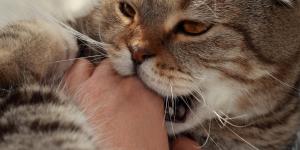My Neutered Cat Keeps Marking



See files for Cats
Neutering your cat provides many benefits. Not only does it prevent unwanted pregnancies, but the procedure safeguards both male and female cats from certain health issues. Behavioral problems are also avoided, especially those related to reproductive behaviors. While both male and female cats will mark their territory by spraying, male cats often do it more. Although there are different reasons why cats mark, reproduction is a key factor. Female cats mark when they are in heat to notify males of their presence. Males mark to do the same to females, as well as alert rival cats to a challenge.
Since spaying and neutering cats prevents reproductive behaviors, we may be surprised when our neutered cat keeps marking. At AnimalWised, we explain the reasons for this behavior and how we can best prevent it in the future.
Do neutered cats stop marking?
Cats secrete pheromones from different parts of their body. The main forms of marking are:
- Facial: although it is also a sign the cat loves you, rubbing their head and face against you is also a way to mark. This is because pheromones from the cheek region are secreted when doing so.
- Paws: we may think our cat only scratches at our furniture to keep their nails in check, but there is another important reason. Scent glands are located interdigitally on the cat's paws. When they scratch, pheromones are released which are used for marking purposes.
- Urine: urine spraying is one of the most efficient and effective methods of marking in cats. Spraying allows the cat to spread their scent out over longer distances and does so with a greater potency. They raise their tail and spray a small amount over a certain area.
Spraying is a common action to mark territory. For females, this is most important when they are in heat as they want to attract a male. For males, spraying alerts the female cat to their presence for copulation and notifies males they will have a challenge if they want to mate with the same female.
For female cats, spaying removes the sex organs and usually stops spraying behavior completely. If they continue to mark, it may be due to another reason or is more common in cats which are spayed after their first heat. Previous studies have show a reduction in spraying behavior of male cats with more recent studies showing it to have great efficacy in this area[1].
Although neutering can reduce spraying behavior or stop it altogether, facial and nail marking will persist. Since these types of marking also have other purposes and causes, it is important they are not prevented. We explain more in the following sections.
Learn more with our related article on whether neutered cats have the urge to mate.

1. Face marking
Facial marking occurs when the cat rubs their face against you, other animals or even inanimate objects. The scent glands for marking do not only exist on the face. They can also be found on the sides of the body and other areas, one of the reasons cats often walk through our legs while rubbing.
The purpose of this behavior is to leave an olfactory mark, but it is not usually related to reproduction. Although cats in heat will rub themselves against almost anything, cats still perform this behavior because it helps develop the bond with their guardian, makes them feel secure in their home environment and is also a simple display of affection.
Since cats rubbing their face and body against objects is a positive expression of their feline nature, we should not try to prevent it. Doing so can cause the cat great distress and seriously affect their behavior and wellbeing.

2. Marking with claws
As with all other types of marking, scratching with paws has multiple purposes. When outside, cats scratch trees and other suitable landmarks to show other cats they are present. They are also simply taking care of their nails. A cat's nails will become painful if they are too long, so they scratch against hard surfaces to keep them conditioned.
Cats will usually scratch an upright surface. It is for this reason we often see them scratching the legs of tables or the arms of couches. They do this from the time they are kittens and their nails start growing. Since domestic felines don't always have the right surface to scratch their claws, their guardians often have to trim them. This prevents injuries to the cat's paw pads which can seriously harm their wellbeing.
Spaying or neutering cats does not have any effect on their paw marking behavior. They will still need to maintain and condition their claws. It also appears to be a behavior that cats enjoy and is a normal expression of their feline nature. Unfortunately, when cats keep scratching the furniture or other objects, it can become a nuisance. We cannot stop scratching, but we can redirect or lessen the behavior with the following tips:
- Scratching post: scratching posts use material which the cats like to scratch. It encourages them to scratch because it feels good. We can also use scratching trees and other cat accessories with scratching strips as a form of feline environmental enrichment.
- Catnip: a spray with catnip can be used to help the cat feel better. It can prevent problematic scratching. Do not spray it on the scratching post itself as they may consider it marked by another cat.
- Multi-cat households: if we have many cats in the same home, we need to be generous with our scratching opportunities. We need to provide scratching posts for each cat, plus some extra to share.
- Protectors: use scratching protectors on sofas and other objects you don't want to be ruined. It can be difficult to stop a cat scratching any area, so this way the cat can be happy, but your valuables are also protected.
As with the other types of marking, it is important we socialize the cat from when they are a young age. This way we can help them to feel calm and relaxed, meaning they won't need to scratch as much. Since scratching can make the cat feel good, they often scratch more when they are nervous. If we provide a happy environment and meet all of their care needs, we can also reduce problematic scratching.

3. Urine marking (spraying)
Spraying behavior is a common issue with cat guardians. Since we want to have a clean and hygienic home, spraying can cause great disturbances. It is also usually performed by a cat which is frustrated or has some issue with their wellbeing. Unlike marking with the face or paws, spraying is something we should try to prevent in cats.
When cats mark with urine, they usually spray on vertical surfaces. They lift their tail to achieve a clean spraying direction, as well as tense their body. They may also shake their legs during the act. Although the cat will spray urine all over the home, they will only do so in small bursts and should still use their litter box. Urinating or defecating outside the litter box is not the same as marking with urine or feces.
As stated above, spraying behavior usually greatly reduces or desists after they are spayed or neutered. However, some cats will continue to spray after they are neutered. This is usually for one of the following reasons:
- Litter box problems: when litter boxes are not cleaned enough, the cat may spray elsewhere out of protest. This is the same if the litter box is inappropriate. It may be too small, have a hard to enter door or even use litter which the cat does not like. Also, the amount you have is important. Although two cats can share one litter box, it is important they have at least one each with an additional one to share.
- Stress: although neutering tends to steady a cat's behavior, a neutered cat can still become stressed. Stressors in their environment can include a change of home, a new family member entering the home, loud noises and many others. Removing these stressors can help stop the cat marking with spray.
- Disease: there are certain diseases which can cause urinary incontinence in cats. This means the cat often doesn't have time to reach the litter box. Although it can seem like they are urine marking, they may simply be urinating because they can't help it. You will need to take them to a veterinarian for assessment and administration of any necessary treatment.
- Boredom: another common problem with spraying is the cat not being sufficiently stimulated. It is a common behavior in indoor cats as they don't experience the outdoor stimuli that other cats do. In some cases, allowing the cat to have outdoor access stops the problematic marking. However, it is often more to do with guardians not spending enough time with the cat or not provide sufficient environmental enrichment.
Although neutered cats should reduce their spraying, some may continue this behavior. Neutered cats are much more likely to mark with urine if they are unhappy, stressed or neglected. As with all cat behaviors, it provides information about their wellbeing. Since a physical cause needs to be ruled out, we should take the cat to a veterinarian.
If the cat is physically fine, we need to assess their environment and our own care. We need to ensure their diet is correct, they have enough opportunity for exercise and we spend enough time with them. If the marking behavior continues after this, we should contact a feline ethologist. They can assess the individual cat's needs and provide practical help.

If you want to read similar articles to My Neutered Cat Keeps Marking, we recommend you visit our Behavioral problems category.
1. Cafazzo, S., Bonanni, R., & Natoli, E. (2019). Neutering Effects on Social Behaviour of Urban Unowned Free-Roaming Domestic Cats. Animals: an open access journal from MDPI, 9(12), 1105. https://doi.org/10.3390/ani9121105








